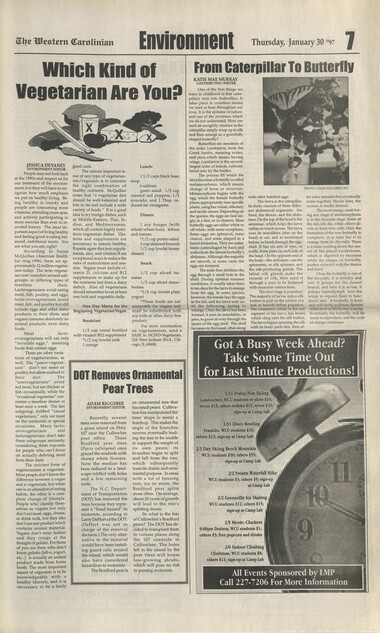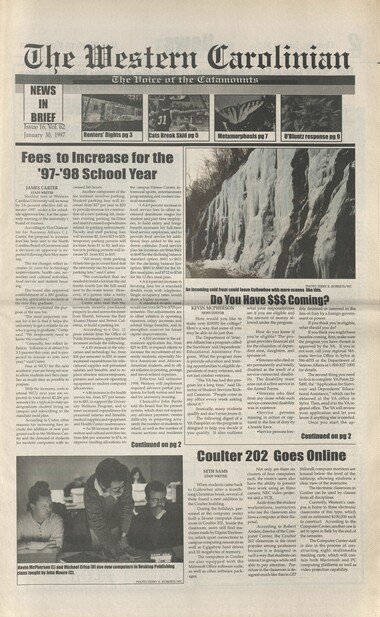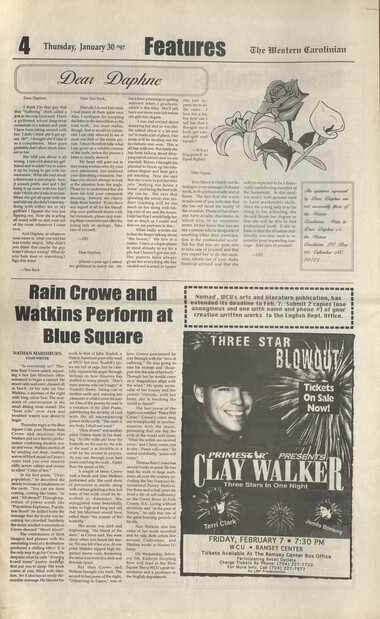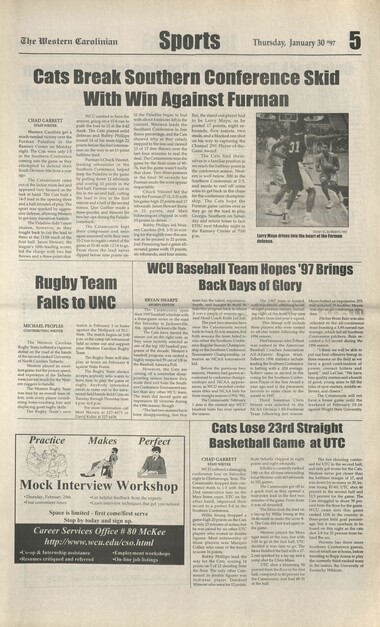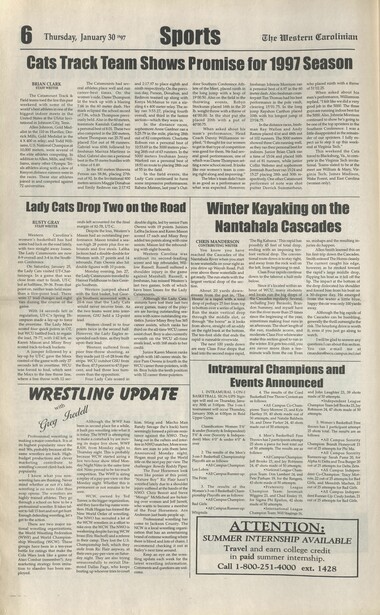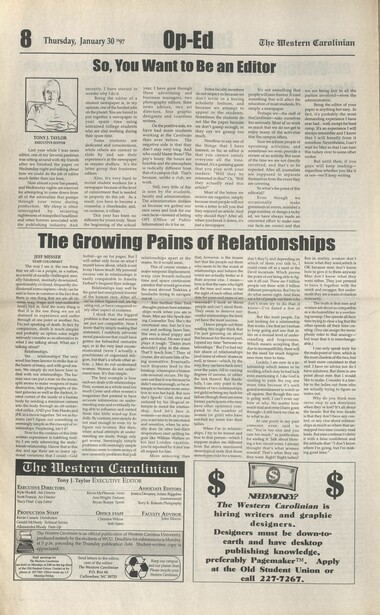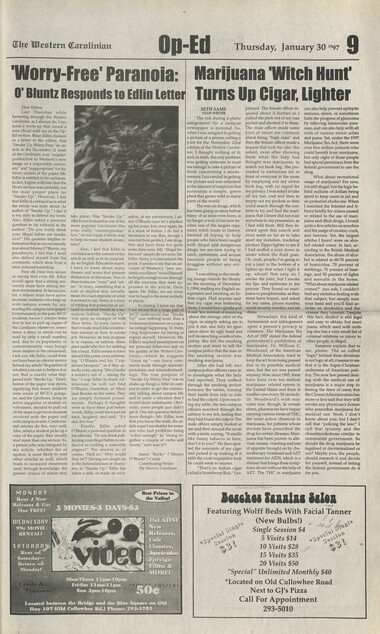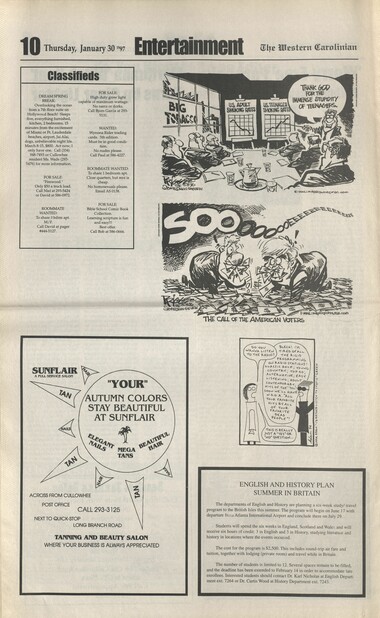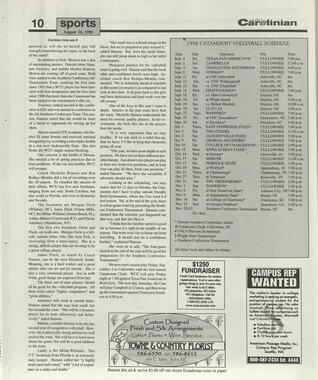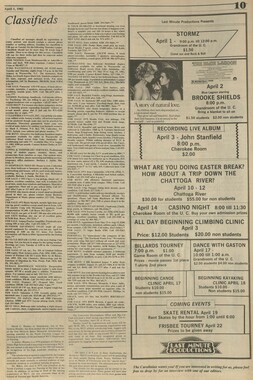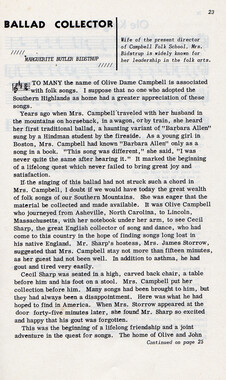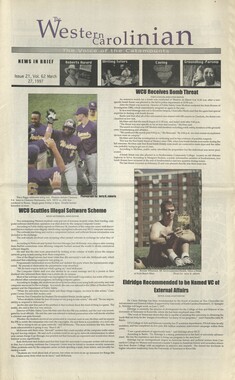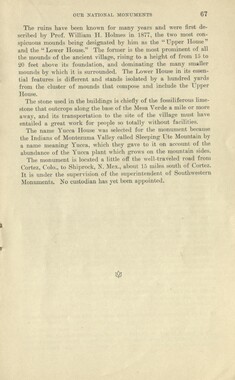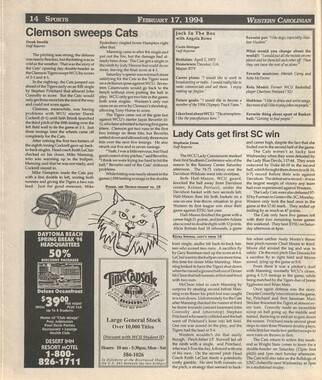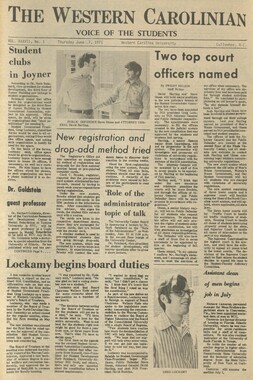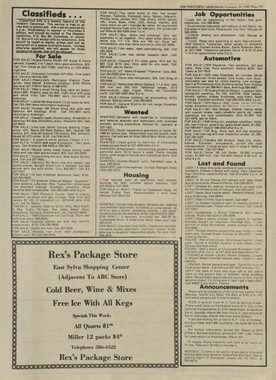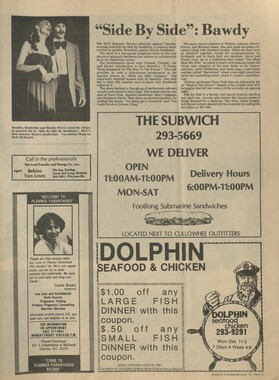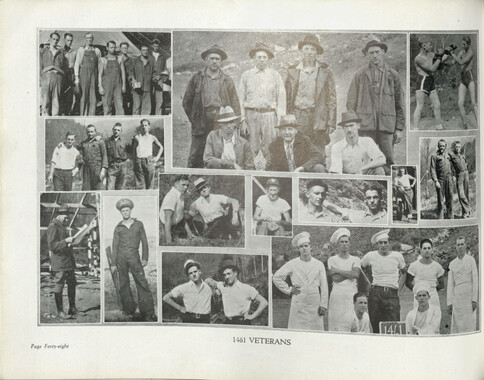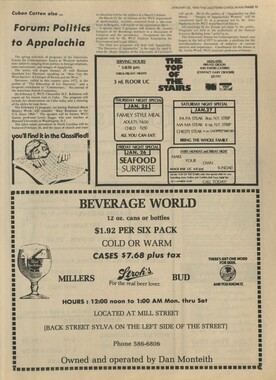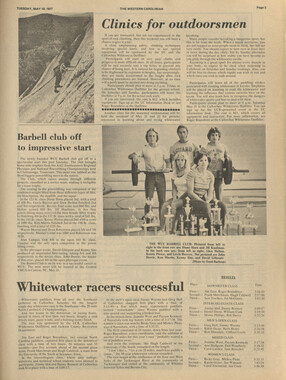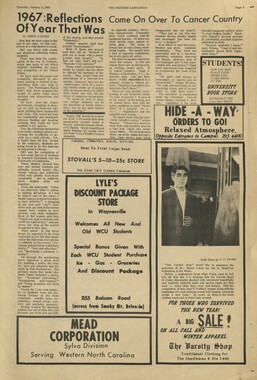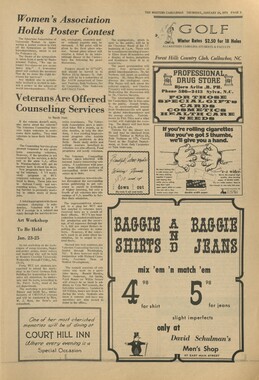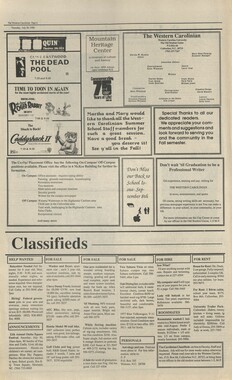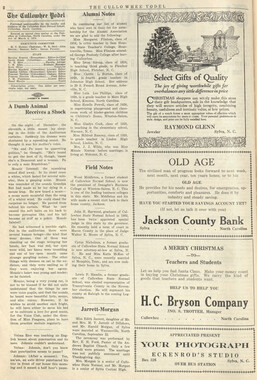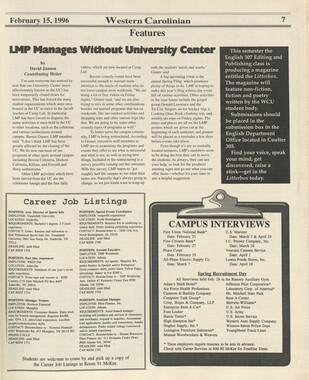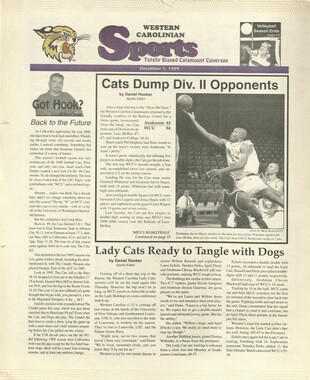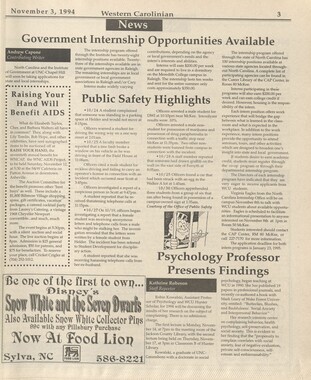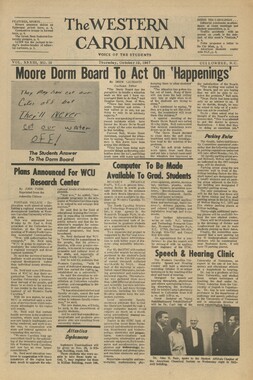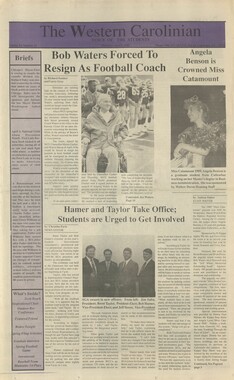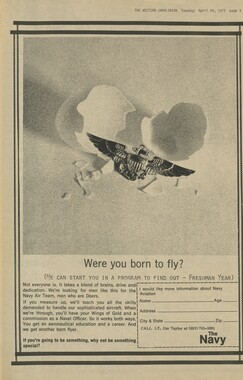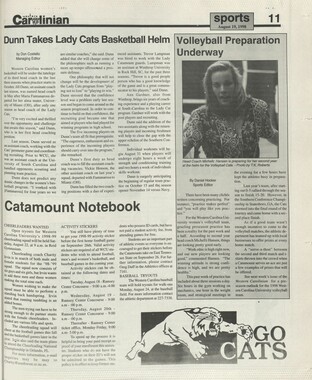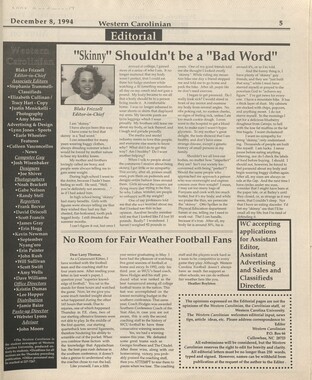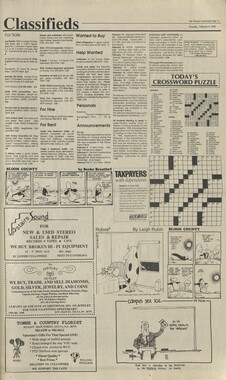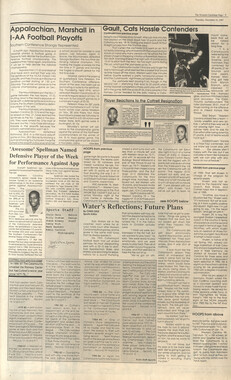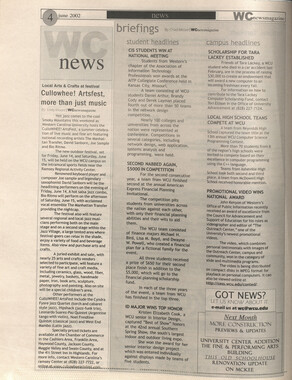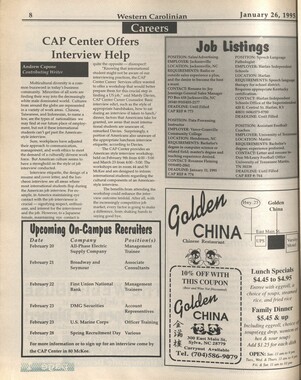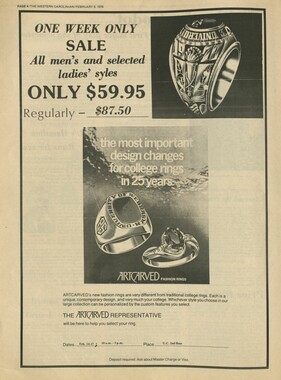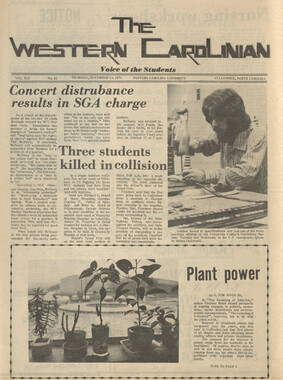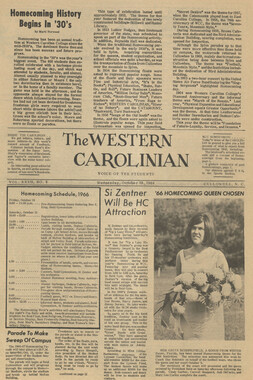Western Carolina University (20)
View all
- Canton Champion Fibre Company (2308)
- Cherokee Traditions (293)
- Civil War in Southern Appalachia (165)
- Craft Revival (1942)
- Great Smoky Mountains - A Park for America (2767)
- Highlights from Western Carolina University (430)
- Horace Kephart (941)
- Journeys Through Jackson (154)
- LGBTQIA+ Archive of Jackson County (26)
- Oral Histories of Western North Carolina (314)
- Picturing Appalachia (6772)
- Stories of Mountain Folk (413)
- Travel Western North Carolina (160)
- Western Carolina University Fine Art Museum Vitreograph Collection (129)
- Western Carolina University Herbarium (92)
- Western Carolina University: Making Memories (708)
- Western Carolina University Publications (2283)
- Western Carolina University Restricted Electronic Theses and Dissertations (146)
- Western North Carolina Regional Maps (71)
- World War II in Southern Appalachia (131)
University of North Carolina Asheville (6)
View all
- Allanstand Cottage Industries (62)
- Appalachian National Park Association (53)
- Bennett, Kelly, 1890-1974 (1388)
- Berry, Walter (76)
- Brasstown Carvers (40)
- Carver, George Washington, 1864?-1943 (26)
- Cathey, Joseph, 1803-1874 (1)
- Champion Fibre Company (233)
- Champion Paper and Fibre Company (297)
- Cherokee Indian Fair Association (16)
- Cherokee Language Program (22)
- Crowe, Amanda (40)
- Edmonston, Thomas Benton, 1842-1907 (7)
- Ensley, A. L. (Abraham Lincoln), 1865-1948 (275)
- Fromer, Irving Rhodes, 1913-1994 (70)
- George Butz (BFS 1907) (46)
- Goodrich, Frances Louisa (120)
- Grant, George Alexander, 1891-1964 (96)
- Heard, Marian Gladys (60)
- Kephart, Calvin, 1883-1969 (15)
- Kephart, Horace, 1862-1931 (313)
- Kephart, Laura, 1862-1954 (39)
- Laney, Gideon Thomas, 1889-1976 (439)
- Masa, George, 1881-1933 (61)
- McElhinney, William Julian, 1896-1953 (44)
- Niggli, Josephina, 1910-1983 (10)
- North Carolina Park Commission (105)
- Osborne, Kezia Stradley (9)
- Owens, Samuel Robert, 1918-1995 (11)
- Penland Weavers and Potters (36)
- Roberts, Vivienne (15)
- Roth, Albert, 1890-1974 (142)
- Schenck, Carl Alwin, 1868-1955 (1)
- Sherrill's Photography Studio (2565)
- Southern Highland Handicraft Guild (127)
- Southern Highlanders, Inc. (71)
- Stalcup, Jesse Bryson (46)
- Stearns, I. K. (213)
- Thompson, James Edward, 1880-1976 (226)
- United States. Indian Arts and Crafts Board (130)
- USFS (683)
- Vance, Zebulon Baird, 1830-1894 (1)
- Weaver, Zebulon, 1872-1948 (58)
- Western Carolina College (230)
- Western Carolina Teachers College (282)
- Western Carolina University (1794)
- Western Carolina University. Mountain Heritage Center (18)
- Whitman, Walt, 1819-1892 (10)
- Wilburn, Hiram Coleman, 1880-1967 (73)
- Williams, Isadora (3)
- Cain, Doreyl Ammons (0)
- Crittenden, Lorraine (0)
- Rhodes, Judy (0)
- Smith, Edward Clark (0)
- Appalachian Region, Southern (2399)
- Asheville (N.C.) (1917)
- Avery County (N.C.) (26)
- Blount County (Tenn.) (161)
- Buncombe County (N.C.) (1671)
- Cherokee County (N.C.) (283)
- Clay County (N.C.) (555)
- Graham County (N.C.) (233)
- Great Smoky Mountains National Park (N.C. and Tenn.) (510)
- Haywood County (N.C.) (3522)
- Henderson County (N.C.) (70)
- Jackson County (N.C.) (4692)
- Knox County (Tenn.) (25)
- Knoxville (Tenn.) (12)
- Lake Santeetlah (N.C.) (10)
- Macon County (N.C.) (420)
- Madison County (N.C.) (211)
- McDowell County (N.C.) (39)
- Mitchell County (N.C.) (132)
- Polk County (N.C.) (35)
- Qualla Boundary (981)
- Rutherford County (N.C.) (76)
- Swain County (N.C.) (2113)
- Transylvania County (N.C.) (247)
- Watauga County (N.C.) (12)
- Waynesville (N.C.) (73)
- Yancey County (N.C.) (72)
- Aerial Photographs (3)
- Aerial Views (60)
- Albums (books) (4)
- Articles (1)
- Artifacts (object Genre) (228)
- Bibliographies (1)
- Biography (general Genre) (2)
- Cards (information Artifacts) (38)
- Clippings (information Artifacts) (191)
- Crafts (art Genres) (622)
- Depictions (visual Works) (21)
- Design Drawings (1)
- Drawings (visual Works) (184)
- Envelopes (73)
- Facsimiles (reproductions) (1)
- Fiction (general Genre) (4)
- Financial Records (12)
- Fliers (printed Matter) (67)
- Glass Plate Negatives (381)
- Guidebooks (2)
- Internegatives (10)
- Interviews (812)
- Land Surveys (102)
- Letters (correspondence) (1013)
- Manuscripts (documents) (619)
- Maps (documents) (177)
- Memorandums (25)
- Minutes (administrative Records) (59)
- Negatives (photographs) (5835)
- Newsletters (1285)
- Newspapers (2)
- Occupation Currency (1)
- Paintings (visual Works) (1)
- Pen And Ink Drawings (1)
- Periodicals (193)
- Personal Narratives (10)
- Photographs (12976)
- Plans (maps) (1)
- Poetry (7)
- Portraits (1960)
- Postcards (329)
- Programs (documents) (151)
- Publications (documents) (2237)
- Questionnaires (65)
- Scrapbooks (282)
- Sheet Music (2)
- Slides (photographs) (402)
- Songs (musical Compositions) (2)
- Sound Recordings (796)
- Specimens (92)
- Speeches (documents) (15)
- Tintypes (photographs) (8)
- Transcripts (322)
- Video Recordings (physical Artifacts) (23)
- Vitreographs (129)
- Text Messages (0)
- A.L. Ensley Collection (275)
- Appalachian Industrial School Records (7)
- Appalachian National Park Association Records (336)
- Axley-Meroney Collection (2)
- Bayard Wootten Photograph Collection (20)
- Bethel Rural Community Organization Collection (7)
- Blumer Collection (5)
- C.W. Slagle Collection (20)
- Canton Area Historical Museum (2110)
- Carlos C. Campbell Collection (282)
- Cataloochee History Project (65)
- Cherokee Studies Collection (4)
- Daisy Dame Photograph Album (5)
- Daniel Boone VI Collection (1)
- Doris Ulmann Photograph Collection (112)
- Elizabeth H. Lasley Collection (1)
- Elizabeth Woolworth Szold Fleharty Collection (4)
- Frank Fry Collection (95)
- George Masa Collection (173)
- Gideon Laney Collection (452)
- Hazel Scarborough Collection (2)
- Hiram C. Wilburn Papers (28)
- Historic Photographs Collection (236)
- Horace Kephart Collection (861)
- Humbard Collection (33)
- Hunter and Weaver Families Collection (1)
- I. D. Blumenthal Collection (4)
- Isadora Williams Collection (4)
- Jesse Bryson Stalcup Collection (47)
- Jim Thompson Collection (224)
- John B. Battle Collection (7)
- John C. Campbell Folk School Records (80)
- John Parris Collection (6)
- Judaculla Rock project (2)
- Kelly Bennett Collection (1407)
- Love Family Papers (11)
- Major Wiley Parris Civil War Letters (3)
- Map Collection (12)
- McFee-Misemer Civil War Letters (34)
- Mountain Heritage Center Collection (4)
- Norburn - Robertson - Thomson Families Collection (44)
- Pauline Hood Collection (7)
- Pre-Guild Collection (2)
- Qualla Arts and Crafts Mutual Collection (12)
- R.A. Romanes Collection (681)
- Rosser H. Taylor Collection (1)
- Samuel Robert Owens Collection (94)
- Sara Madison Collection (144)
- Sherrill Studio Photo Collection (2558)
- Smoky Mountains Hiking Club Collection (616)
- Stories of Mountain Folk - Radio Programs (374)
- The Reporter, Western Carolina University (510)
- Venoy and Elizabeth Reed Collection (16)
- WCU Gender and Sexuality Oral History Project (32)
- WCU Mountain Heritage Center Oral Histories (25)
- WCU Oral History Collection - Mountain People, Mountain Lives (71)
- WCU Students Newspapers Collection (1744)
- Western North Carolina Tomorrow Black Oral History Project (69)
- William Williams Stringfield Collection (2)
- Zebulon Weaver Collection (109)
- African Americans (390)
- Appalachian Trail (35)
- Artisans (521)
- Cherokee art (84)
- Cherokee artists -- North Carolina (10)
- Cherokee language (21)
- Cherokee pottery (101)
- Cherokee women (208)
- Church buildings (167)
- Civilian Conservation Corps (U.S.) (110)
- College student newspapers and periodicals (1830)
- Dams (103)
- Dance (1023)
- Education (222)
- Floods (61)
- Folk music (1015)
- Forced removal, 1813-1903 (2)
- Forest conservation (220)
- Forests and forestry (1058)
- Gender nonconformity (4)
- Great Smoky Mountains National Park (N.C. and Tenn.) (181)
- Hunting (38)
- Landscape photography (10)
- Logging (103)
- Maps (84)
- Mines and mineral resources (8)
- North Carolina -- Maps (18)
- Paper industry (38)
- Postcards (255)
- Pottery (135)
- Railroad trains (71)
- Rural electrification -- North Carolina, Western (3)
- School integration -- Southern States (2)
- Segregation -- North Carolina, Western (5)
- Slavery (5)
- Sports (452)
- Storytelling (245)
- Waterfalls -- Great Smoky Mountains (N.C. and Tenn.) (66)
- Weaving -- Appalachian Region, Southern (280)
- Wood-carving -- Appalachian Region, Southern (328)
- World War, 1939-1945 (173)
Western Carolinian Volume 62 Number 16
Item
Item’s are ‘child’ level descriptions to ‘parent’ objects, (e.g. one page of a whole book).
-
-
®tf£ ffllestern Carolinian Environment Thursday, January 301997 7 Which Kind of Vegetarian Are YouP JESSICA DEVANEY ENVIRONMENT EDITOR People may not look back at the 1990s and respect us for our treatment of the environment, but they will have to recognize how much emphasis we put on healthy living. Being healthy is trendy and people are consuming more vitamins, attending more spas, and actively participating in more exercise than ever in recorded history. The most important aspect of living healthy and feeling good is eating balanced, nutritional meals. You are what you eat, right? According to Susan McQuillan (American Health, Jul.-Aug.1996), there are approximately 12 million vegetarians today. The term vegetarian now considers several subgroups, or differing types of meatless diets. Lactovegetarians avoid eating meat, fish, poultry, and eggs; lacto-ovovegetarians avoid meat, fish, and poultry but still include eggs and other dairy products in their diets; and vegans consume absolutely no animal products, even dairy foods. Most lacto- ovovegetarians will eat only "invisible eggs," meaning foods that contain eggs. There are other variations of vegetarianism, as well. The "pesco-vegetar- ians" don't eat meat or poultry, but allow seafood in their diet. The "semivegetarians" avoid red meat, but eat chicken or fish occasionally, while the "occasional vegetarian" consumes a meatless dinner at least once a week. The last subgroup, dubbed "casual vegetarians," only eat meat on the weekends or special occasions. Many lacto- ovovegetarians and lactovegetarians don't take these subgroups seriously, considering them cop-outs for people who can't focus on actually deleting meat from their diets. The strictest form of vegetarianism is veganism. Most people don't know the difference between a vegan and a vegetarian, but while one is an alteration of eating habits, the other is a complete change of lifestyle. People who classify themselves as vegans not only don't eat meat, eggs, cheese, or drink milk, but they also don't use any product which contains animal material. Vegans don't wear leather and they cringe at the thought of gelatin. For those of you out there who don't know, gelatin (Jell-o, yogurt, etc..) is actually an animal product made from horse hoofs. The most important aspect of veganism is to be knowledgeable with a healthy lifestyle, and it is neccessary to be a fairly good cook. The utmost important issue of any type of vegetarianism/veganism is to consume the right combination of healthy nutrients. McQuillan notes that "a vegetarian diet should be well-balanced and low in fat and include a wide variety of foods." It is a good idea to try foreign dishes, such as Middle-Eastern, Thai, Indian, and Mediterranean, which all contain highly nutritious vegetarian dishes. Vitamins and supplements are neccessary to remain healthy. Experts agree that iron supplements, zinc, and vitamin B are exceptional ways to reduce the risks of malnutrition and anemia. Vegans must include vitamin D, calcium and B12 supplements to make up for the nutrients lost from a dairy deficit. Also all vegetarians should remember to eat at least one fruit and vegetable daily. One Day Menu for the Beginning Vegetarian/Vegan Breakfast: 1/2 cup cereal fortified with vitamin B12 supplement *l/2 cup lowfat milk 1 orange Lunch: 11/2 cups black bean soup 6 saltines green salad: 1/2 cup roasted red peppers, 1/2 avocado, and 1 Tbsp. reduced-fat vinaigrette Dinner: 1 soy burger (with whole-wheat bun): lettuce and tomato *l/2 cup potato salad 1 cup steamed broccoli 1 /2 cup lowfat frozen dessert Snack: 1/2 cup sliced bananas 1/2 cup sliced strawberries "1/2 cup lowfat plain yogurt *These foods are not acceptable for vegans and must be substituted with soy milk or other dairy-free product. For more information on vegetarianism, send a SASE to NCND-Vegetarian, 216 West Jackson Blvd., Chicago, IL 60606. DOT Removes Ornamental Pear Trees ADAM RIGGSBEE ENVIRONMENT EDITOR Recently, several trees were removed from a grass island on Hwy. 107 near the Cullowhee post office. These Bradford pear trees (Pyrus calleryana) once graced the roadside with showy white flowers. Now the median has been reduced to a landscape riddled with holes and a few remaining roots. The N.C. Department of Transportation (DOT) has removed the trees because they represent a "fixed hazard" to motorists, according to Larry DeHart of the DOT. (DeHart was not in charge of the removal decision.) The only alternative to the removal would have been installing guard rails around the island, which would also have considered hazardous to motorists. The Bradford pear is an ornamental tree that has small pears. Cultivation has manipulated the trees' shape to mimic a teardrop. This makes the angle of the branches narrow, eventually leading the tree to be unable to support the weight of its own pears; its branches begin to split and fall from the tree, which subsequently loses its charm and ornamental purpose. In areas with a lot of freezing rain, ice or snow, the Bradford pear splits more often. On average, about 20 years of growth will lead to the tree's splitting doom. So what is the fate of Cullowhee's Bradford pears? The DOT has decided to transplant them to various places along the 107 roadside in Cullowhee. The holes left in the island by the pear trees will house low-growing shrubs, which will pose no risk to passing motorists. From Caterpillar To Butterfly KATIE MAE MURRAY CONTRIBUTING WRITER One of the first things we learn in childhood is that caterpillars turn into butterflies. It takes place in countless stories we read or hear throughout our lives. It is the epitome of nature, and one of the processes which we do not understand. How can such an unsightly creature as the caterpillar simply wrap up in silk and then emerge as a gracefully elegant butterfly? Butterflies are members of the order Lepidoptera, from the Greek lepidos, meaning scales, and pfera,which means having wings. Lepidoptera is the second- largest order of insects, outnumbered only by the beetles. The process BY which the larva becomes a butterfly is called metamorphosis, which means change of form or structure. Metamorphosis begins with the egg, which the female butterfly places appropriately near specific plants, using her visual, olfactory, and tactile senses. Depending on the species, the eggs are laid singly, in a line, or in clusters. Most butterfly eggs are either white or off-white, with some exceptions. Some eggs are spherical, some conical, and some shaped in a barrel formation. They are sometimes camouflaged by hairs and scales from the female butterfly's abdomen. Although the majority are smooth, in some cases the eggs are textured. The male then fertilizes the egg through a small hole in the shell. During optimal summer conditions, it usually takes three to ten days for the larva to emerge from the egg. In some species, however, the female lays the eggs in the fall, and the larva wait until the following spring to emerge. Once the larva has been formed, it uses its mandables, or jaws, to gnaw its way through the layers of the egg shell. The shell becomes its first meal, often along PHOTO ADAM RIGGSBEE/WC with other hatched eggs. The larva is the caterpillar. Its body consists of three different abdominal segments: the head, the thorax, and the abdomen. On the top of the head is the antennae, which helps the larva utilize its touch senses. The larva uses its mandibles (also on the head) to eat, and as mentioned before, to break through the eggshell. It has six sets of eyes, or ocelli, three pairs on each side of the head. On the opposite end of the body—the abdomen—are the spinnerets, or silk spinners, and the silk-producing glands. The labial silk glands make the strands of silk, then send it through a duct to be flattened with muscular contractions. The next stage is pupation. The majority of larvae spin a silk button or pad on the surface of a leaf or branch before pupation. The cremasteT, which is the last segment of the larva, has hooks which cling onto the silk button. The larva begins spinning the silk with its body parts free, then af ter a few minutes they eventually come together. Hours later, the cocoon, is finally formed. The most energy used during any stage of metamorphosis is in the chrysalis stage. Some of the old cells die, while others divide to form new cells. Once the formation of the new butterfly is complete, it is time for it to emerge from its chrysalis. There is a seam running down the center of the pupal exoskeleton, which is digested by enzymes while the imago, or butterfly, pushes outward with the thorax and head. Once the butterfly is out of the chrysalis, it is wrinkly and wet. It grasps for the closest branch, and once it is secure, it pumps haemolymph into the wings to expand them to functional size. A butterfly is born and will freely pollinate EVpwers while feed on the nower' s nectar. Eventually the butterfly will be ready to reproduce, and the cycle of change continues. Got A Busy Week Ahead? Take Some Time Out for Last Minute Productions! 1/31 Friday Nite Skiing Cataloochee; WCU students w/ skies $10 w/out $15; others w/skies $15, w/out $20; sign-up at Camp Lab 1/31 Disco Bowling Franklin; WCU students $10; others $13; sign-up at Camp Lab 2/1 Day Skiing Beech Mountain WCU students $50; others $55; sign-up at Camp Lab 2/2 Frozen Waterfall Hike WCU students $3; others $5; sign-up at Camp Lab 2/2 Greenville Ice Skating WCU students $12; others $15; sign-up at Camp Lab 2/5 Movie: Clockers 9:00pm Dodson; WCU students $1; others $3; free popcorn and drinks 2/6 Indoor Climbing Climbmax; WCU students $8; others $11; sign-up at Camp Lab All Events Sponsored by LMP Call 227-7206 For More Information
Object
Object’s are ‘parent’ level descriptions to ‘children’ items, (e.g. a book with pages).
-
The Western Carolinian is Western Carolina University's student-run newspaper. The paper was published as the Cullowhee Yodel from 1924 to 1931 before changing its name to The Western Carolinian in 1933.
-
